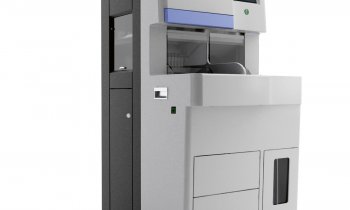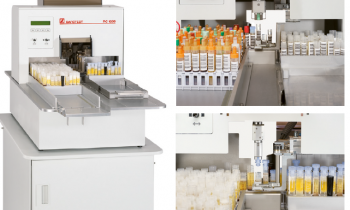Biochips
The way forward
Due to economic pressure, laboratories increasingly consolidate and automate procedures. Further cost reductions could come about through miniaturisation and multi-parameter tests.
Both allow fast responses to several target parameters with one sample. Biochips, especially DNS chips, have been developed furthest. But other test formats, such as bead technologies or microfluidic systems are also promising.
While DNA chips have already gained a certain commercial relevance, first-generation developments in protein chip technologies will be introduced to the market shortly. However, such developments can meet severe resistance - as in Germany, where no billing procedure has been implemented.
Biochips are small specimen trays onto which biological material has been applied for analysis. Biochips are also referred to as arrays, whereby target molecules* are aligned in a specific order on the chip surface, making it possible to match the results. (*Here the term target molecule is used for molecules that are bound to the chip surface with a known identity. The free molecules whose identity is to be determined are referred to as assay molecules). Immobilised spots of under 200-µm diameter are referred to as microarrays; if larger than 300-µm they are called macroarrays. There are now arrays with up to several 100,000 spots on one chip.
Silicon, glass, glass steamed with gold, polymers (nylon membrane, other synthetics) and aluminium are used as carrier materials. Individual biological molecules (DNA, RNA, peptides, proteins) or complete cells are immobilised on the surface, which is modified when necessary.
There is a large range of procedures available for immobilisation.
The differentiation is between in-situ and ex-situ procedures. In the in-situ procedure molecules are synthesised directly on the surface of the biochip. DNA chips in particular are manufactured according to this procedure. In the ex-situ procedure molecules are synthesised outside the chip and defined amounts are applied to the chip afterwards. Molecules are applied using instruments called spotters or nanoplotters, which apply solutions on the chip surface in a pl-ratio or nl-ratio. Spotting differentiates between contact procedures and non-contact procedures.
In contact procedures a stamp or a pin dips into the solution to be spotted and prints it on the carrier material. In doing so, the pin’s tip touches the chip’s surface. In non-contact procedures the spotter pin does not touch the surface, but the liquid is sprayed on (similar to inkjet printers, e.g. piezo-electric spotting). A non-contact procedure is particularly preferable when manufacturing protein chips, to prevent damage to protein structures.
Different procedures are used for biomolecules that are to be immobilised, to bind them to the surface of the biochip. The binding can be a direct adsorption to the chip surface, or appropriately activated surfaces. Furthermore, special coatings have been developed that enable a maximally reproducible biomolecule binding. These include special hydrophobic coatings and a coating with nitro-cellulose or with special matrices, also used in protein clearing.
Generally, biochips for various applications are produced by a corresponding manufacturer and the user carries out the analysis of materials. But now there are complete systems for a biochip assay. Immobilisation of the target molecule on the chip surface is the first fully automated step, then the binding reaction with corresponding molecules from samples to be analysed and finally the detection and evaluation of the results by using specific software.
Objectives and advantages
Smaller analysis systems lead to enormous cost saving. Use of test tubes, microtiter disks and reagents decreases. A significantly smaller sample volume is required, due to increased sensitivity of the microarrays. Analyses are simultaneous, saving time. Several thousand parameters can be analysed in a single experiment. High automation increases reproducibility several-fold.
Applications - Mainly medical and pharmaceutical but also in the food industry (e.g. identifying genetically modified foods), and in the environment, to prove contamination by certain bacteria.
At present, biochips are classified according to their surface molecules: DNA chips, protein chips, cell chips, lab-on-a-chip.
DNA chips - The first biochips and still dominating the biochip market. A few years ago US firm Affymetrix led the way with Gene-Chip, and today just one can contain up to 400 000 spots.
Target molecules of DNA chips are short fragments of single-stranded nucleic acid with known identity, either oligodesoxynucleotides, cDNA, RNA or entire chromosomes. PCR amplification and oligonucleotide synthesis allow efficient production of a variety of highly specialised target molecules. The target DNA can be of human origin, but also of a mouse, yeast, or several bacteria. DNA molecules can be immobilised either by in-situ or ex-situ synthesis.
Samples are culled from the nucleic acids of the biological material to be analysed. Prior to analysis, these nucleic acids must be labelled, in most cases with fluorescent dyes, sometimes with enzymes or radioactively.
The basic principle of the DNA chip assay is hybridisation of the target molecules immobilised on the chip surface with the free and labelled molecules of the sample. Single-strand nucleic acid molecules of the analysis will bond to complementary strands on the chip with high specificity.
Bound and labelled sample molecules are identified either optically or electrically. With optical detection, fluorescence, luminescence, or the radioactive radiation of the previously labelled sample molecules are measured. Quantification is based on the strength of signals. The higher the concentration of the screened substance in the sample, the stronger the signal.
Electrical detection is based on the fact that single strand DNA has a lower conductivity than DNA double strands and therefore a discrimination between hybridised and non-hybridised DNA is possible.
Currently, DNA chips are well-established, high throughput hybridisation systems. One single experiment can generate a huge amount of data that can be analysed with specialised software.
Source: VGD
01.07.2003











